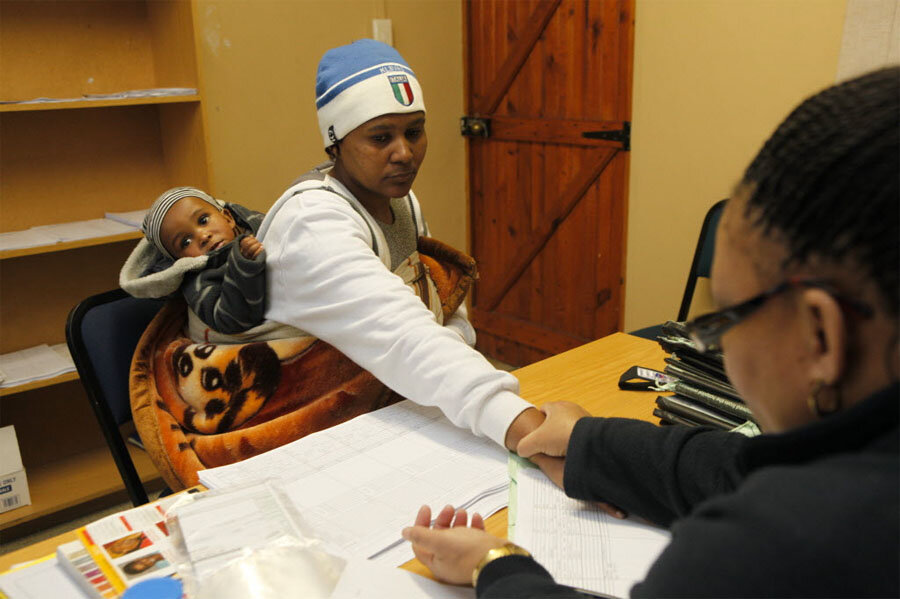HIV/AIDS: What's behind the decline in new infections
Loading...
Global efforts in recent decades to combat the spread of HIV/AIDS – reported to have killed some 39 million people – appear to be having an effect. The number of newly infected individuals worldwide is down 38 percent since 2001.
Increased government investment in prevention, broad public-information campaigns on healthy behavior, and improved access to health care all are credited with contributing to the decline.
According to a recent United Nations report, the number of people newly infected fell from 3.4 million in 2001 to 2.1 million by 2013.
In sub-Saharan Africa, where the epidemic hit hard and is still highly prevalent, the reduction was significant: 34 percent, with progress made in particular among men and children.
The sharpest decline in new infections – more than 50 percent – occurred in 26 far-flung countries including Cambodia, Togo, Botswana, Nepal, Senegal, and Thailand.
In some countries – especially in Latin America and Asia-Pacific regions – the rate of decline in new HIV infections has been considerably slower, however.
The overall decline is largely attributable to the combined and continued efforts by national governments and international agencies to increase awareness of and drive behavioral shifts to safer sexual practices, observers say.
In Zimbabwe, for example, a reduction in multiple sexual partners is cited. Other factors credited include improved access to antiretroviral treatment and a mobilization of finances aimed at programs to curb the epidemic.
“The extraordinary acceleration of finances and high increase of investment by governments is the primary reason in preventing new infections, particularly in regions where adults and children are at high risk,” says Vivian Lopez, an HIV specialist for UNICEF, which works closely with the Joint United Nations Program on HIV/AIDS on eradication efforts. “Recently, there has been a lot of learning among populations,” she says. “More people are getting tested, and prevention programs have worked – specifically in sub-Saharan Africa, where we have prioritized ourselves to reduce mother-to-child transmission.”
These findings, in the aggregate, showcase the milestones achieved in the fight against HIV/AIDS.
But the goal to completely end the pandemic remains a major challenge. An estimated 35 million people are said to be living with HIV worldwide, and while new infections have fallen globally, some regions show signs of a countertrend.
Eastern Europe, for example, saw a 5 percent rise between 2005 and 2013, with an estimated 1.2 million infections in Russia alone. That nation now accounts for more than 50 percent of new infections in the region.
Similarly, Indonesia is experiencing a steep rise – up a reported 48 percent since 2005.
One common cause of HIV infections in regions reporting increases: the use of dirty needles to inject drugs. Since the late 1990s, Russia has seen a surge in drug use and addiction. Among those officially registered there as having been diagnosed with HIV, most reportedly became infected through contaminated needles.
It is also difficult to contain the spread of HIV, clearly, in countries where governments have not prioritized and implemented prevention programs, for whatever reason.
“People in many parts of the world, like Russia and Indonesia, are stigmatized,” says Ms. Lopez. “They suffer for two reasons. Mostly, HIV infections are happening in marginal groups like [transgender people], commercial sex workers, drug users ... and [the behaviors of] these groups are often criminalized. There are punitive and discriminatory laws against these groups that prevent them from seeking essential health care and treatment plans.”
While other diseases – such as the Ebola virus – pose threats on a global scale, keeping HIV high on national and international agendas remains a challenge. Significant research on HIV vaccines still hasn’t yielded any breakthroughs. And experts maintain that continued improvement on strategies, policies, investment and allocation of funds, and health care are needed to more effectively fight this stubborn epidemic.
Still, there is optimism on the front lines.
“We are working toward achieving an AIDS-free generation,” says Lopez. “We’ve achieved a lot so far, and we can stop AIDS.”







